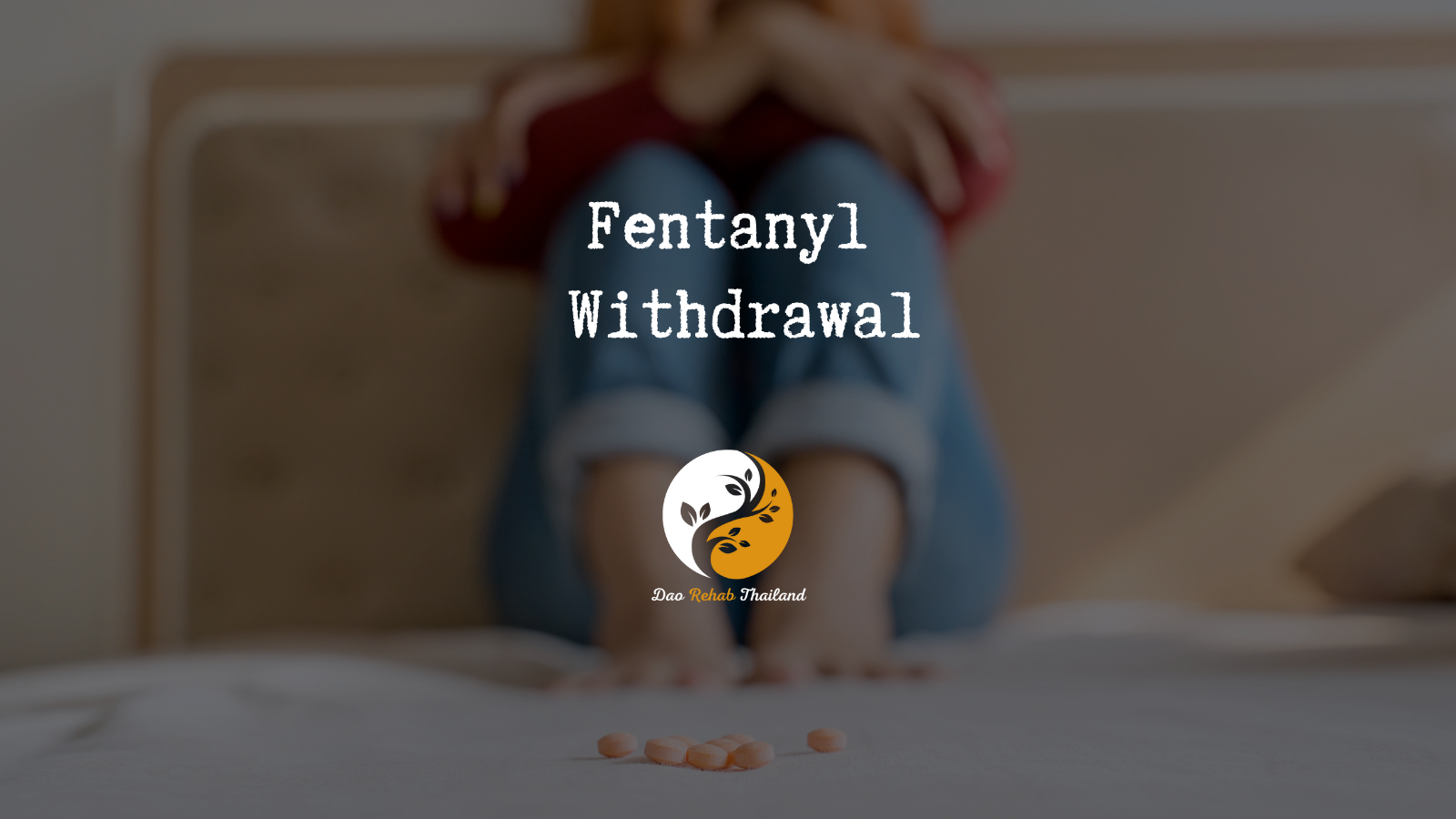
Fentanyl Withdrawal in thailand
Fentanyl Withdrawal
“Turning the impossible into possible”

"Detox from Fentanyl at a Luxury Holistic Center in Thailand and Israel"

Detox from Fentanyl
Fentanyl is a potent synthetic opioid that is significantly stronger than morphine and heroin. It is used medically for severe pain management but has become a major factor in the opioid crisis due to its high potency and risk for addiction. Withdrawal from fentanyl can be challenging and intense, requiring a comprehensive approach for effective management.
Fentanyl detox at DaoTherapy takes place in a supportive environment focused on holistic healing. The detox process includes a gradual reduction in dosage, guided by professionals, to ease severe withdrawal symptoms. Patients participate in treatments such as yoga, meditation, and breathing techniques, which help reduce anxiety and improve self-awareness. The therapeutic team provides emotional support, guidance, and tools for coping with challenges, fostering a sense of belonging. DaoTherapy’s approach not only facilitates the cessation process but also promotes personal and spiritual growth, leading to an improved quality of life and deep psychological recovery after a challenging addiction like that to fentanyl.
"Holistic Center for Trauma, Addiction, and Mental Imbalance Treatment in Thailand"
“Come to the beginning of your journey to freedom from addiction to alcohol, drugs, and pills, and rediscover your life within the serene embrace of DaoTherapy Rehab in Thailand—where holistic healing meets empowering recovery.”
DaoTherapy Holistic Rehab
Key Elements of Fentanyl Detox:
Medical Supervision: Fentanyl detox must be conducted under medical supervision, as the body may experience withdrawal symptoms. These can include nausea, anxiety, muscle aches, and insomnia. A medical team will monitor and manage these symptoms to ensure the patient’s safety and comfort.
Holistic Therapies:
Holistic Therapies: Many detox programs incorporate holistic therapies such as mindfulness, yoga, and meditation to help individuals cope with stress and anxiety during the detox process. These therapies support the mind-body connection and contribute to overall recovery.
Tapering Process
Tapering Process: Fentanyl detox often involves a gradual tapering of the drug to reduce withdrawal severity. Doctors will slowly decrease the dosage over time to allow the body to adjust to lower levels of the substance.
Psychological Support:
Psychological Support: Like any addiction recovery process, detox from Fentanyl includes psychological support. This can involve counseling, therapy, or support groups to address the mental and emotional aspects of addiction.
Post-Detox Treatment:
Post-Detox Treatment: After completing detox, continuing treatment is crucial to prevent relapse. This often includes participation in ongoing therapy, group support, and the development of new coping strategies to maintain sobriety.
What You Need to Know About Fentanyl (Fenta) Withdrawal:
Fentanyl, often referred to by its nickname “Fenta,” is an extremely potent synthetic opioid that is up to 100 times stronger than morphine. It is used for severe pain management but has become a significant factor in the opioid crisis due to its high potential for addiction and overdose. Withdrawal from fentanyl can be severe and requires careful management. Here’s what you need to know:
1. Severity and Potency of Fentanyl:
Fentanyl’s high potency means that dependence and addiction can develop quickly, even with medical use. Withdrawal from fentanyl can be more intense than withdrawal from other opioids due to its powerful effects on the brain’s opioid receptors.
2. Withdrawal Symptoms:
Fentanyl withdrawal symptoms can be severe and are similar to those of other opioids but may occur more rapidly and with greater intensity:
– Physical Symptoms:
– Severe muscle and joint pain
– Nausea, vomiting, and diarrhea
– Abdominal cramping
– Sweating, chills, and goosebumps
– Runny nose and watery eyes
– Insomnia and restlessness
– Rapid heart rate and high blood pressure
– Tremors and fatigue
– Psychological Symptoms:
– Intense anxiety and restlessness
– Irritability and mood swings
– Depression
– Strong cravings for fentanyl
– Difficulty concentrating
3. Timeline of Withdrawal:
– Early Phase (6-24 hours after last use): Initial symptoms, such as anxiety and restlessness, may begin.
– Peak Phase (2-4 days): The most severe symptoms typically appear, including intense pain, gastrointestinal issues, and insomnia.
– Late Phase (5-10 days): Symptoms begin to decrease in intensity but may still include fatigue, depression, and trouble sleeping.
– Post-Acute Withdrawal Syndrome (PAWS)**: Lingering symptoms such as mood swings, sleep disturbances, and cravings can last for weeks or months.
4. Managing Fentanyl Withdrawal:
– Medical Supervision: Due to the risk of severe withdrawal symptoms and complications, fentanyl withdrawal should always be managed under medical supervision. This ensures that the process is safe and that any complications can be promptly addressed.
– Medication-Assisted Treatment (MAT):
– Buprenorphine or Methadone: These medications can help ease withdrawal symptoms by providing controlled activation of opioid receptors.
– Clonidine: May be used to manage physical withdrawal symptoms such as high blood pressure and anxiety.
– Gradual Tapering: Reducing the dose slowly, rather than stopping abruptly, can help minimize withdrawal symptoms.
– Hydration and Nutrition: Staying hydrated and eating a balanced diet can support the body’s recovery.
– Therapeutic Support:
– Counseling and Behavioral Therapy**: Essential for addressing the psychological impact of withdrawal and building coping strategies.
– Holistic Therapies: Activities like yoga, meditation, and deep breathing exercises can help manage stress and promote emotional balance.
5. Risks and Precautions:
– Relapse and Overdose: Individuals who relapse after detox are at a higher risk of overdose because their tolerance to the drug has decreased. Relapse prevention strategies and ongoing support are crucial.
– Medical Complications: Severe dehydration, high blood pressure, or cardiac issues may occur and should be monitored by healthcare professionals.
6. Building a Support System:
– Family and Community Support: Engaging family and trusted friends in the recovery process can provide emotional and moral support.
– Support Groups: Joining groups such as Narcotics Anonymous (NA) or other peer support organizations can help maintain long-term sobriety.
7. Aftercare and Relapse Prevention:
– Comprehensive Aftercare Plans: After detox, a structured aftercare plan that includes therapy, counseling, and support group participation is essential for sustained recovery.
– Coping Strategies: Learning to identify and manage triggers, as well as developing healthy coping mechanisms, is key to avoiding relapse.
Conclusion:
Withdrawal from fentanyl is a serious and challenging process that requires medical attention, careful planning, and support. With proper medical supervision, medication-assisted treatment, and psychological support, individuals can navigate withdrawal safely and begin their journey to recovery. Ongoing care and support are vital for preventing relapse and maintaining long-term recovery.

contact us
Contact us with your questions
We would love to speak with you! Feel free to reach out with any questions.

get in touch
Schedule a free consultation
Schedule a free consultation with our team and let’s make things happen!
Historical Background and Development of Fentanyl:
1. Discovery and Early Development:
Fentanyl was first synthesized in 1960 by Dr. Paul Janssen, the founder of Janssen Pharmaceutica, a Belgian pharmaceutical company. Dr. Janssen and his team were searching for a potent analgesic that could provide strong pain relief for surgical and medical procedures. The development of fentanyl marked a significant advancement in pain management due to its high potency, which is approximately 50-100 times stronger than morphine.
2. Initial Medical Use:
Fentanyl was initially introduced in the 1960s as an intravenous anesthetic under the brand name Sublimaze. Its powerful effects made it highly effective for use in surgery and for managing severe post-operative pain. The drug’s ability to act quickly and provide significant pain relief led to its widespread adoption in hospitals and surgical centers.
3. Expansion of Fentanyl Products:
Over time, pharmaceutical companies developed various forms of fentanyl to meet different medical needs:
– Transdermal Patches (Duragesic): In the 1990s, fentanyl patches were introduced for the treatment of chronic pain, allowing the drug to be absorbed slowly through the skin over several days. This innovation provided long-lasting pain relief for patients with conditions like cancer and severe chronic pain.
– Buccal Tablets, Lozenges, and Nasal Sprays: Other delivery methods, such as buccal tablets (Fentora), lozenges (Actiq), and nasal sprays, were developed for faster absorption and relief of breakthrough pain.
4. Mechanism of Action:
Fentanyl works by binding to the mu-opioid receptors in the brain and central nervous system, which blocks the transmission of pain signals and induces pain relief, sedation, and euphoria. Due to its high lipophilicity, fentanyl can quickly cross the blood-brain barrier, contributing to its rapid onset of action and powerful effects.
5. Role in Pain Management:
Fentanyl became a critical medication for managing severe pain, particularly in patients who were tolerant to other opioids. Its use expanded in palliative care, where it was employed to alleviate chronic cancer pain and other severe conditions that required potent pain management.
6. Emergence in Illicit Drug Markets:
In the early 2000s, fentanyl began appearing in the illicit drug market, contributing significantly to the opioid crisis. Its potency made it appealing for illicit drug manufacturers, who mixed it with other substances like heroin and counterfeit prescription pills to increase profit margins. The result was an increase in accidental overdoses, as users were often unaware of the presence or amount of fentanyl in their drugs.
7. The Opioid Crisis:
The rise in misuse and the subsequent spike in overdose deaths turned fentanyl into a major public health concern. According to the Centers for Disease Control and Prevention (CDC), synthetic opioids, primarily fentanyl, have been a leading cause of opioid-related overdose deaths in the United States. The highly potent nature of fentanyl means that even small amounts can be lethal, particularly when mixed with other drugs.
8. Regulatory Measures and Response:
To address the crisis, governments and health organizations have implemented stricter regulations on the prescription and distribution of fentanyl. Public health initiatives aim to increase awareness, improve access to naloxone (an opioid overdose reversal drug), and expand treatment options for opioid use disorder.
9. Current Medical and Illicit Use:
Today, fentanyl remains an important medication in medical practice for managing severe pain under strict supervision. However, its presence in the illicit drug market continues to pose significant challenges. Synthetic analogs of fentanyl, such as carfentanil, which is even more potent, have exacerbated the issue, leading to further public health concerns.
Conclusion:
Fentanyl’s development was a breakthrough in pain management, offering powerful relief for those with severe pain conditions. However, its potency has also led to significant challenges, particularly in the context of misuse and the opioid crisis. While it remains an essential tool in the medical field, its impact on public health continues to be profound, requiring careful regulation, education, and support to mitigate risks associated with its use.
Information about Fentanyl and Its Mechanism of Action:
What is Fentanyl?
Fentanyl is a synthetic opioid analgesic that is significantly more potent than morphine and heroin—estimated to be 50-100 times stronger than morphine. It is primarily used to treat severe pain, such as pain from surgery or chronic conditions like cancer. Due to its high potency, fentanyl has also become a major factor in the opioid crisis, contributing to a rise in overdose deaths.
Mechanism of Action:
Fentanyl works by binding to the mu-opioid receptors in the brain and central nervous system. These receptors are part of the body’s pain control system, which, when activated, reduce the sensation of pain and produce feelings of euphoria and sedation.
Key Points of Fentanyl’s Mechanism of Action:
1. Binding to Opioid Receptors:
– Fentanyl selectively binds to mu-opioid receptors with high affinity, which results in potent analgesic (pain-relieving) and sedative effects.
– This binding prevents the transmission of pain signals, offering substantial pain relief.
2. Rapid Onset and High Potency:
– Fentanyl is highly lipophilic, allowing it to cross the blood-brain barrier quickly, resulting in a rapid onset of action.
– Its potency allows for effective pain relief at lower doses compared to other opioids, which contributes to its medical effectiveness but also its potential for abuse and overdose.
3. Central Nervous System Depression:
– Fentanyl can depress the respiratory centers in the brain, which can lead to respiratory depression. This effect is dose-dependent and poses significant risks, especially when combined with other CNS depressants like alcohol or benzodiazepines.
Medical Uses:
– Severe Pain Management: Fentanyl is used in various medical settings, including for patients with severe, chronic pain that cannot be managed with less potent painkillers.
– Anesthesia: It is often used as part of anesthesia for surgery due to its fast-acting and potent pain-relief properties.
– Palliative Care: Fentanyl patches or lozenges may be used for cancer patients who need continuous pain relief.
Forms of Administration:
– Transdermal Patches (Duragesic): Release fentanyl slowly over 48 to 72 hours for long-term pain management.
– Buccal Tablets and Lozenges (Actiq): Provide rapid relief for breakthrough pain.
– Nasal Sprays and Injections: Used for quick pain relief in clinical settings.
Side Effects:
– Common Side Effects:
– Drowsiness
– Dizziness
– Constipation
– Nausea and vomiting
– Severe Side Effects:
– Respiratory Depression: One of the most serious risks, potentially leading to death if breathing becomes too slow or stops.
– Bradycardia: Slowed heart rate.
– Hypotension: Low blood pressure.
– Confusion and Sedation: Mental clouding and severe drowsiness.
Risks and Addiction Potential:
– Fentanyl’s high potency and quick onset make it highly addictive. Dependence can develop rapidly, and misuse can result in overdose.
– Overdose Risk: Due to its potency, even a small amount of fentanyl can lead to overdose, marked by severe respiratory depression, loss of consciousness, and death.
– Illicit Use: Illicitly manufactured fentanyl is often mixed with other drugs, such as heroin or cocaine, without users’ knowledge, significantly increasing the risk of overdose.
Precautions:
– Medical Supervision: Fentanyl should only be used under strict medical guidance, especially for those with respiratory issues or a history of substance abuse.
– Avoid Mixing with Other CNS Depressants: Combining fentanyl with other substances that depress the central nervous system, such as alcohol or sedatives, can greatly increase the risk of life-threatening side effects.
Conclusion:
Fentanyl is a powerful tool in pain management and anesthesia, valued for its efficacy and rapid action. However, its high potency makes it risky, with a significant potential for abuse and overdose. Understanding fentanyl’s mechanism of action and its associated risks is essential for safe use in medical settings and for awareness in addressing its role in the opioid crisis.
Common Side Effects of Fentanyl:
Fentanyl, while effective for managing severe pain, can lead to a range of side effects. These side effects can vary in severity and frequency depending on the individual, dosage, and method of administration. Here are the common side effects associated with fentanyl use:
1. Drowsiness and Sedation:
– Fentanyl often causes drowsiness and sedation, which can impact an individual’s ability to perform tasks that require alertness, such as driving or operating machinery.
2. Dizziness:
– Users may experience lightheadedness or dizziness, particularly when standing up suddenly due to the drug’s effects on blood pressure.
3. Constipation:
– As with other opioids, fentanyl can slow down the digestive system, leading to constipation. This may require dietary adjustments or medication to manage.
4. Nausea and Vomiting:
– These gastrointestinal symptoms are common, especially at the beginning of treatment or when doses are adjusted.
5. Dry Mouth:
– Fentanyl can cause a reduction in saliva production, leading to a dry mouth, which can contribute to dental issues if not managed.
6. Sweating:
– Excessive sweating is another side effect that some users experience while taking fentanyl.
7. Headaches:
– Headaches can occur as a result of fentanyl use, varying in intensity from mild to severe.
8. Itching or Rash:
– Some individuals may experience itching or develop a mild rash due to fentanyl’s effect on the body’s histamine response.
9. Weakness and Fatigue:
– General feelings of tiredness or muscle weakness can be present, affecting overall energy levels.
10. Loss of Appetite:
– Decreased appetite or changes in eating habits may occur during fentanyl use.
Important Note on Side Effects:
While these are common side effects, it’s crucial to monitor them, as they can sometimes be precursors to more serious conditions. For instance, severe drowsiness or confusion may indicate potential overdose, especially if combined with other central nervous system depressants.
Management of Side Effects:
– Medical Consultation: Always consult with a healthcare provider if side effects are persistent or troublesome.
– Lifestyle Adjustments: Simple changes, such as staying hydrated, eating fiber-rich foods for constipation, and taking breaks to manage drowsiness, can help mitigate some side effects.
– Medication Adjustments: Doctors may adjust dosage or suggest alternative pain management strategies if side effects become problematic.
Understanding and recognizing the common side effects of fentanyl is essential for safe use. Patients using fentanyl should be vigilant and communicate with their healthcare providers to manage side effects effectively and prevent complications.
Psychological Support:
Psychological Support: Like any addiction recovery process, detox from Subutex includes psychological support. This can involve counseling, therapy, or support groups to address the mental and emotional aspects of addiction.
Addiction to Fentanyl:
Fentanyl addiction is a serious and growing concern, particularly given its high potency and widespread availability. Fentanyl is a synthetic opioid that is 50-100 times more potent than morphine, making it highly effective for pain relief but also extremely addictive. Here is what you need to know about fentanyl addiction:
1. How Fentanyl Addiction Develops:
– Potency and Euphoria: Fentanyl’s strong effects on opioid receptors in the brain lead to intense euphoria and pain relief. This can result in a rapid development of physical dependence and addiction as the brain adapts to the presence of the drug.
– Tolerance: Over time, users may need higher doses to achieve the same effects due to tolerance, which can accelerate the path to addiction.
– Illicit Use: Fentanyl is not only available in prescription form but is also produced illegally and often mixed with other drugs like heroin or counterfeit pills. Users may unknowingly ingest fentanyl, increasing the risk of addiction and overdose.
2. Signs and Symptoms of Fentanyl Addiction:
– Physical Dependence: Needing to use fentanyl regularly to avoid withdrawal symptoms such as muscle aches, nausea, sweating, and severe anxiety.
– Compulsive Use: An overwhelming urge to use the drug, often leading to risky behavior or obtaining it through illegal means.
– Behavioral Changes: Prioritizing drug use over personal, professional, or social responsibilities. This can include neglecting family, work, or hobbies.
– Mood Swings: Intense mood swings, including periods of euphoria followed by irritability, anxiety, or depression.
– Withdrawal Symptoms: Experiencing withdrawal symptoms when not using fentanyl, which can include severe pain, vomiting, diarrhea, insomnia, and restlessness.
– Cravings: Persistent, strong cravings for fentanyl that make it difficult to quit.
3. Physical and Psychological Effects of Fentanyl Addiction:
– Physical Effects: Long-term use can lead to significant physical health problems, including weakened immune function, respiratory depression, and severe constipation.
– Mental Health Impact: Addiction to fentanyl can exacerbate mental health issues such as depression and anxiety. It can also lead to confusion, paranoia, and, in severe cases, hallucinations.
4. Risks and Consequences:
– Overdose: One of the most dangerous aspects of fentanyl addiction is the risk of overdose. Due to its high potency, even a small amount can lead to life-threatening respiratory depression and death.
– Fatal Interactions: Mixing fentanyl with other substances, such as alcohol or benzodiazepines, increases the risk of fatal overdose.
– Illicit Manufacturing: Illicit fentanyl is often mixed with other drugs, making it difficult for users to know the true potency of what they are taking. This unpredictability contributes to the high rates of overdose.
5. Treatment for Fentanyl Addiction:
– Medical Detox: Detoxing from fentanyl should be done under medical supervision due to the severity of withdrawal symptoms. Medically-assisted detox can help manage symptoms safely.
– Medication-Assisted Treatment (MAT):
– Buprenorphine and Methadone: These medications can help reduce cravings and withdrawal symptoms by binding to opioid receptors in a controlled way.
– Naltrexone: Can block the effects of opioids and reduce cravings.
– Behavioral Therapy: Counseling and cognitive-behavioral therapy (CBT) can address the psychological aspects of addiction and provide coping mechanisms.
– Support Groups: Joining support groups such as Narcotics Anonymous (NA) can offer a community of individuals facing similar challenges, which can be an invaluable part of the recovery process.
6. Long-Term Management and Relapse Prevention:
– Ongoing Support: Continuous therapy, participation in support groups, and structured aftercare plans are crucial for maintaining long-term sobriety.
– Lifestyle Changes: Building a healthy routine that includes exercise, mindfulness practices, and meaningful social interactions can support recovery.
– Relapse Triggers: Identifying and managing triggers, such as stress and social situations associated with drug use, is key to preventing relapse.
Fentanyl addiction is a serious condition that requires comprehensive treatment involving medical, psychological, and social support. The high potency of fentanyl makes it highly addictive and increases the risk of overdose. Recognizing the signs and symptoms of addiction and seeking professional help are crucial steps toward recovery and preventing the severe consequences associated with fentanyl use.
DaoTherapy is a psychological and spiritual treatment method.
DaoTherapy is a psychological and spiritual treatment method that focuses on the body, mind, and spirit as one, drawing from the principles of the 12 Steps, psychology, Eastern philosophy, and Taoism. This method aims to bring the individual to inner harmony and balance across all areas of life.
Key Principles of DaoTherapy:
1. Harmony and Balance:
– Emphasis on achieving inner harmony and balance between the body, mind, and spirit.
– Focusing on balancing opposing forces (such as Yin and Yang) and reaching a state of natural flow in life.
2. Use of Meditation and Mindfulness:
– Incorporating meditation and mindfulness techniques to help individuals stay present and experience inner peace and tranquility.
– Developing the ability to focus and be present to handle stress and pressure effectively.
3. Physical Work:
– Incorporating physical exercises such as yoga, Tai Chi, Qi Gong, and soft martial arts to release tension, improve physical health, and increase positive energy.
4. Holistic Approach:
– Addressing all aspects of an individual’s life: physical, emotional, mental, and spiritual.
– Working through these layers to achieve overall health improvement and well-being.
5. Connection with Nature and Environment:
– Engaging in activities in nature and nature-based focus techniques to help individuals connect with their surroundings and achieve harmony with the natural world.
6. Working with Emotions and Thoughts:
– Exploring emotions and thoughts to understand the root causes of destructive patterns and finding ways to cope with them.
– Encouraging self-acceptance and the development of self-compassion.
Benefits of DaoTherapy:
– Reducing Stress and Anxiety: The meditative and physical practices can help reduce stress and anxiety and foster a sense of calm and tranquility.
– Improving Physical Health: Physical exercises and bodywork contribute to overall health and enhanced physical function.
– Developing Self-Awareness: Working with emotions and thoughts can lead to higher self-awareness and a deeper understanding of oneself.
– Enhancing Quality of Life: The holistic approach can lead to overall improvements in quality of life and well-being.
Who is DaoTherapy Suitable For?:
– Individuals seeking a holistic treatment that addresses all aspects of their lives.
– Those who wish to enhance their sense of inner harmony and balance.
– People dealing with stress, anxiety, or pressure who prefer natural methods of treatment.
– Individuals aiming to develop greater self-awareness and gain deeper life insights.
DaoTherapy can be both beneficial and enriching, but it is essential to ensure that the therapist is certified and experienced in this method. Additionally, consulting with an addiction specialist or psychotherapist is recommended before starting new treatment, particularly for complex medical or psychological conditions.
Psychological Support:
Psychological Support: Like any addiction recovery process, detox from Subutex includes psychological support. This can involve counseling, therapy, or support groups to address the mental and emotional aspects of addiction.








